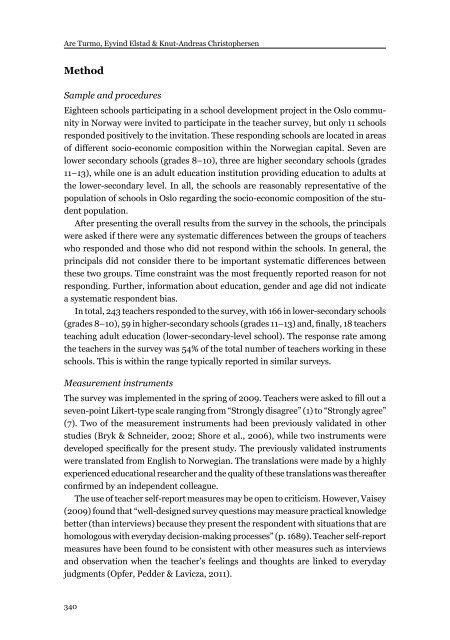Download issue - Umeå universitet
Download issue - Umeå universitet
Download issue - Umeå universitet
Create successful ePaper yourself
Turn your PDF publications into a flip-book with our unique Google optimized e-Paper software.
Are Turmo, Eyvind Elstad & Knut-Andreas Christophersen<br />
Method<br />
Sample and procedures<br />
Eighteen schools participating in a school development project in the Oslo community<br />
in Norway were invited to participate in the teacher survey, but only 11 schools<br />
responded positively to the invitation. These responding schools are located in areas<br />
of different socio-economic composition within the Norwegian capital. Seven are<br />
lower secondary schools (grades 8–10), three are higher secondary schools (grades<br />
11–13), while one is an adult education institution providing education to adults at<br />
the lower-secondary level. In all, the schools are reasonably representative of the<br />
population of schools in Oslo regarding the socio-economic composition of the student<br />
population.<br />
After presenting the overall results from the survey in the schools, the principals<br />
were asked if there were any systematic differences between the groups of teachers<br />
who responded and those who did not respond within the schools. In general, the<br />
principals did not consider there to be important systematic differences between<br />
these two groups. Time constraint was the most frequently reported reason for not<br />
responding. Further, information about education, gender and age did not indicate<br />
a systematic respondent bias.<br />
In total, 243 teachers responded to the survey, with 166 in lower-secondary schools<br />
(grades 8–10), 59 in higher-secondary schools (grades 11–13) and, finally, 18 teachers<br />
teaching adult education (lower-secondary-level school). The response rate among<br />
the teachers in the survey was 54% of the total number of teachers working in these<br />
schools. This is within the range typically reported in similar surveys.<br />
Measurement instruments<br />
The survey was implemented in the spring of 2009. Teachers were asked to fill out a<br />
seven-point Likert-type scale ranging from “Strongly disagree” (1) to “Strongly agree”<br />
(7). Two of the measurement instruments had been previously validated in other<br />
studies (Bryk & Schneider, 2002; Shore et al., 2006), while two instruments were<br />
developed specifically for the present study. The previously validated instruments<br />
were translated from English to Norwegian. The translations were made by a highly<br />
experienced educational researcher and the quality of these translations was thereafter<br />
confirmed by an independent colleague.<br />
The use of teacher self-report measures may be open to criticism. However, Vaisey<br />
(2009) found that “well-designed survey questions may measure practical knowledge<br />
better (than interviews) because they present the respondent with situations that are<br />
homologous with everyday decision-making processes” (p. 1689). Teacher self-report<br />
measures have been found to be consistent with other measures such as interviews<br />
and observation when the teacher’s feelings and thoughts are linked to everyday<br />
judgments (Opfer, Pedder & Lavicza, 2011).<br />
340

















